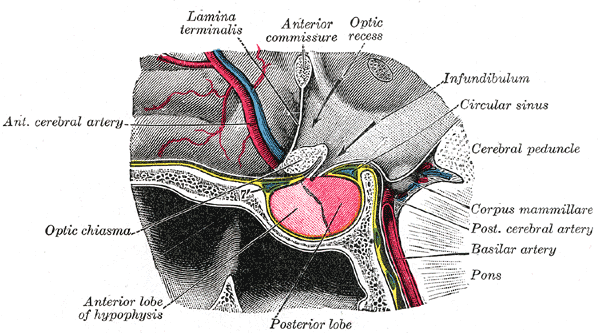Pituitary Stalk Interruption Syndrome

Pituitary stalk interruption syndrome (PSIS) is a congenital abnormality of the pituitary that is responsible for pituitary deficiency and is usually characterized by the triad of a very thin or interrupted pituitary stalk, an ectopic (or absent) posterior pituitary (EPP) and hypoplasia or aplasia of the anterior pituitary visible on MRI. In some patients the abnormality may be limited to EPP (also called ectopic neurohypophysis) or to an interrupted pituitary stalk.
Epidemiology
The prevalence of PSIS is unknown but to date around 1,000 cases with and without the full triad have been reported.
Clinical description
In the neonatal period, PSIS presents with hypoglycemia, prolonged jaundice, congenital abnormalities and microphallus and/or cryptorchidism, which are all suggestive of hypothalamic-pituitary deficiency. PSIS is also associated with higher than normal frequency of breech presentation, Cesarean section and/or low Apgar score. The birth conditions are probably a consequence rather than the cause of PSIS. Later in childhood, signs suggestive of PSIS include short stature, decreased growth rate and/or a difference between the target and actual heights of greater than 1.5 SD. Patients may also present with seizures, hypotension and/or intellectual delay. PSIS can be associated with septooptic dysplasia and Fanconi anemia (see these terms).
Etiology
The exact etiology of PSIS is unknown. Mutations in the transcription factor HESX1 (3p21.2-p21.1) have been found both in patients with isolated PSIS and in those with PSIS associated with septooptic dysplasia. Mutations in the LHX4 gene (1q25) have also been associated with PSIS. In the majority of cases no genetic cause is found, however, the presence of familial forms and the association of PSIS with microphallus and congenital abnormalities, particularly of the eyes, suggest an antenatal origin.
Diagnostic methods
Diagnosis is suspected on clinical findings and on the basis of a low growth hormone (GH) peak after stimulation test and low insulin-like growthfactor 1. MRI, showing EPP as a hypterintense nodule in the region of the infundibular recess of the third ventricle, confirms the diagnosis. The diagnosis of PSIS indicates a permanent GH deficiency. It is necessary to determine if GH deficiency is isolated or associated with other anterior pituitary deficiencies (as occurs in 70% of PSIS). If PSIS is diagnosed from MRI there is no other possible diagnosis.
Genetic counseling
The risk of the familial form is less than or equal to 5%.
Management and treatment
Treatment is based on replacement of deficient hormones, particularly GH, thyroxine, hydrocortisone and, at puberty, sex steroids. It is important to diagnose PSIS at birth to avoid hypoglycemia and secondary adrenal deficiency and their associated cerebral and vital risks.
Prognosis
The prognosis is good if there is timely diagnosis and treatment. Delay in diagnosis and treatment may result in seizures due to hypoglycemia and/or hypotension due to cortisol deficiency and/or intellectual delay due to thyroid deficiency. As a result of these risks, mortality and morbidity in patients with PSIS are higher than in the general population, mainly occurring before 2 years of age.